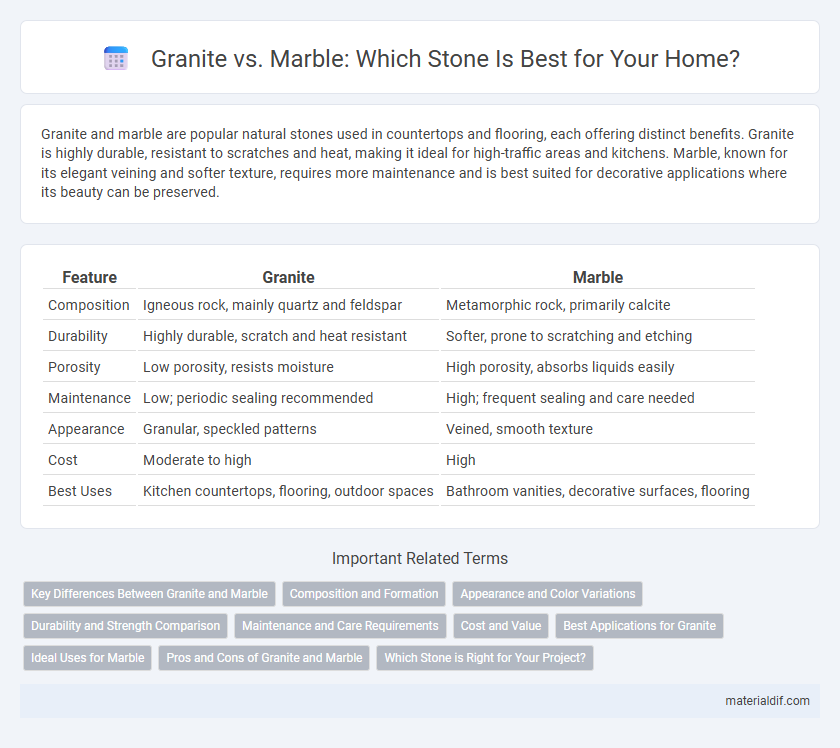Granite and marble are popular natural stones used in countertops and flooring, each offering distinct benefits. Granite is highly durable, resistant to scratches and heat, making it ideal for high-traffic areas and kitchens. Marble, known for its elegant veining and softer texture, requires more maintenance and is best suited for decorative applications where its beauty can be preserved.
Table of Comparison
| Feature | Granite | Marble |
|---|---|---|
| Composition | Igneous rock, mainly quartz and feldspar | Metamorphic rock, primarily calcite |
| Durability | Highly durable, scratch and heat resistant | Softer, prone to scratching and etching |
| Porosity | Low porosity, resists moisture | High porosity, absorbs liquids easily |
| Maintenance | Low; periodic sealing recommended | High; frequent sealing and care needed |
| Appearance | Granular, speckled patterns | Veined, smooth texture |
| Cost | Moderate to high | High |
| Best Uses | Kitchen countertops, flooring, outdoor spaces | Bathroom vanities, decorative surfaces, flooring |
Key Differences Between Granite and Marble
Granite is an igneous rock composed primarily of quartz, feldspar, and mica, making it highly durable and resistant to scratches and heat, while marble is a metamorphic rock mainly consisting of calcite, offering a softer surface prone to scratching and etching. Granite's granular, speckled appearance contrasts with marble's smooth, veined patterns, influencing their aesthetic appeal in countertops and flooring. Maintenance-wise, granite requires less frequent sealing than marble, which is more porous and susceptible to staining from acidic substances.
Composition and Formation
Granite is an igneous rock primarily composed of quartz, feldspar, and mica, formed through the slow crystallization of molten magma beneath the Earth's surface. Marble is a metamorphic rock resulting from the recrystallization of limestone under high pressure and temperature, composed mainly of calcite or dolomite. The mineral composition and formation processes give granite a coarse-grained texture, while marble typically exhibits a fine-grained, often veined appearance.
Appearance and Color Variations
Granite exhibits a granular, speckled appearance with color variations ranging from black, white, pink, to green, offering a natural and speckled texture ideal for modern and rustic designs. Marble features smooth, veined patterns with colors including white, grey, beige, and shades of blue or green, providing a classic, elegant look favored in luxury interiors. The color variations in granite are generally more diverse and vibrant, while marble tends to present softer, more uniform hues with distinctive veining.
Durability and Strength Comparison
Granite exhibits superior durability compared to marble due to its higher resistance to scratches, heat, and stains, making it ideal for high-traffic areas and kitchen countertops. Marble, composed primarily of calcite, is softer and more prone to etching and chipping, which affects its long-term strength and maintenance requirements. Granite's interlocking crystal structure provides exceptional hardness, while marble's softer composition demands more careful use to preserve its aesthetic appeal.
Maintenance and Care Requirements
Granite requires less maintenance due to its dense, non-porous surface that resists stains and scratches, making it ideal for high-traffic areas. Marble is more porous and softer, necessitating regular sealing and cautious cleaning to prevent etching and discoloration from acidic substances. Proper maintenance extends the lifespan of both stones, but granite's durability makes it a more practical choice for low-maintenance environments.
Cost and Value
Granite typically costs between $40 to $100 per square foot, making it a more affordable option compared to marble, which ranges from $50 to $150 per square foot. Granite's durability and resistance to scratching and staining contribute to its long-term value, whereas marble offers a luxurious appearance but requires more maintenance and is more susceptible to damage. Homeowners often choose granite for cost-effectiveness and durability, while marble is favored in high-end applications for its aesthetic appeal despite higher upkeep and expense.
Best Applications for Granite
Granite is highly durable and resistant to scratches, stains, and heat, making it ideal for kitchen countertops and high-traffic areas. Its dense composition allows it to withstand heavy use in commercial spaces and outdoor applications such as paving and cladding. Unlike marble, granite requires less maintenance, ensuring long-lasting beauty and functionality in both residential and industrial environments.
Ideal Uses for Marble
Marble excels in luxurious interior applications such as countertops, fireplace surrounds, and bathroom vanities due to its elegant veining and smooth texture. Its softness compared to granite makes it ideal for decorative elements and sculptural features but less suitable for high-traffic areas prone to scratches. Marble's natural ability to absorb light enhances brightness, making it perfect for spaces aiming for a sophisticated and classic aesthetic.
Pros and Cons of Granite and Marble
Granite offers exceptional durability and resistance to scratches and heat, making it ideal for high-traffic areas and kitchen countertops, while its granular texture provides a wide range of color options. Marble boasts a unique, elegant veining pattern that enhances aesthetic appeal but is softer and more prone to staining and etching from acidic substances. Maintenance for granite is generally lower, requiring periodic sealing, whereas marble demands more frequent sealing and careful cleaning to preserve its surface integrity.
Which Stone is Right for Your Project?
Granite offers exceptional durability and resistance to scratches and stains, making it ideal for high-traffic areas like kitchen countertops and flooring. Marble provides a timeless, elegant appearance with unique veining but requires regular sealing and careful maintenance to prevent etching and staining. Choosing between granite and marble depends on your project's functional demands and aesthetic preferences, with granite favored for durability and marble for classic beauty.
Granite vs Marble Infographic

 materialdif.com
materialdif.com